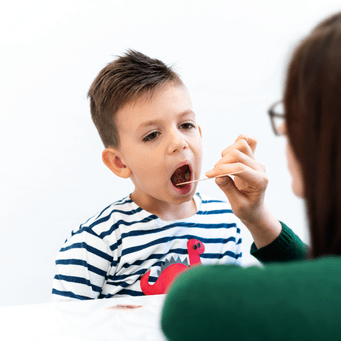Orofacial Myofunctional Disorders (OMDs)
Orofacial Myofunctional Disorders (OMDs)
“Orofacial Myofunctional Disorders are disorders of the muscles and functions of the face and mouth.”
OMDs may affect, directly or indirectly, breastfeeding, facial skeletal growth and development, chewing, swallowing, speech, occlusion (your bite), TMJ (temporomandibular joint) movement, oral hygiene, stability of orthodontic treatment, facial esthetics, and more” according to the Academy of Orofacial Myofunctional Therapy.
Oral Myofunctional Therapy includes exercises that target the muscles of the craniofacial respiratory complex including the mouth and throat. These exercises improve the strength, flexibility, coordination and positioning of the muscles. The tongue, lips and cheeks are often the primary muscle groups but there are other muscles more distant that are often involved as well; for example, the trapezius muscles.
Most OMDs originate with insufficient nasal breathing or primarily mouth breathing and the consequences that follow due to the adaption of muscle patterns and functions. OMDs often affect the treatments by dentists, orthodontists, hygienists, speech-language pathologists, and other professionals working in the orofacial area.

Correct swallow depends on the proper relationship and function of the muscles of the face, mouth, and throat. Swallowing properly requires harmonious cooperation between the nerves and muscles of the tongue, cheeks, and throat. When a person swallows properly the tongue tip presses up firmly onto the hard palate right behind the front teeth. The tongue acts in concert with all the other muscles involved in swallowing. The hard palate absorbs the force created by the tongue forward and laterally.
Because we swallow 1000+ times per day, improper swallow leads to a variety of problems. But it is actually the resting position of the tongue that does the most damage if it is not in the roof of the mouth because it is more constant.
Children, teenagers and adults may suffer from OMDs. OMDs may interfere with the normal growth, development and maintenance of the muscles of the face and mouth (craniofacial respiratory complex). OMDs may also affect these structures’ function such that eating, talking, and breathing are affected.
Signs and Symptoms of Orofacial Myofunctional Disorders:
· Mouth breathing (especially at rest) or has difficulty breathing through their nose
· Limited tongue movement (tongue tie)
· Eating may be messy or difficult. “Picky eaters”
· An overbite, underbite, and/or other dental problems
· Tongue pushing past teeth when a person is not talking or using their tongue (possible tongue or lip ties)
· Speech difficulties. Certain sounds like “S”, “Te”, “SH”, “J” or “L”
· Drooling beyond the age of 2
· Difficulty closing the lips to swallow
· Breathing through mouth during sleep, snoring or sleep apnea
Why Treat OMDs:
In children:
· decrease chance of developmental challenges:
· speech delay
· oral facial development problems (small jaws and crowded teeth)
· reduce neurocognitive challenges and consequences of poor sleep
In adults:
· Improve overall health and well being due to increased recuperation and improved cognitive abilities through deeper sleep
· Improved oral health
· Improved orthodontic retention



